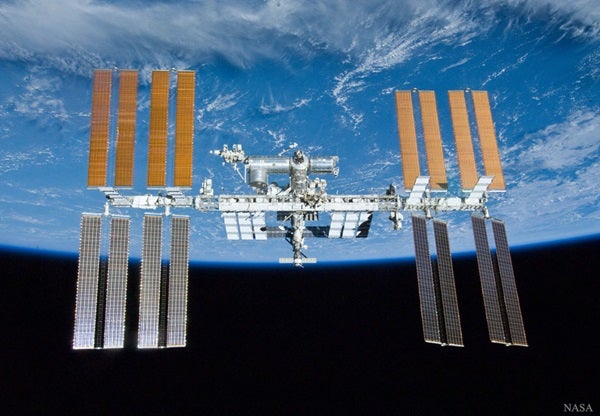NASA’s goal of sending humans to Mars by the 2030s faces many challenges. Now, if all goes well, the American space agency is poised to take one of the first steps toward overcoming those challenges. Although the project is still speculative, NASA and other International Space Station (ISS) partners have begun making plans for a cis-lunar “spaceport” designed to provide a stepping-stone to the Red Planet.
Last month, representatives from five of the world’s space agencies met in Tsukuba, Japan, to discuss their plans for a space station orbiting the Moon. Finalization of the station’s design could come as early as next year. In the ensuing months, these space agencies will begin reviewing plans for a potential cis-lunar station that would serve as proof of concept for many of the challenges that manned missions to asteroids and Mars would pose. Such challenges include the development of deep space life support systems and the integration of human and robotic science and spaceflight operations.
Cis-lunar space is simply the volume of space enclosed by a sphere with a diameter equivalent to the Moon’s orbit. Proving that closed-system, long-term human habitation is manageable here is a necessity before longer missions are planned at distances that don’t allow for easy rescue or resupply. During the meeting in Tsukuba, the ISS partners agreed upon a Near-Rectilinear Halo Orbit, or NRHO, for the station, which would be an oval-shaped loop that would bring the station as close to the Moon as 900 miles (1,500km) and take it out to 43,000 miles (70,000km) throughout a single orbit.
There are several advantages of such an orbit, including minimal need for fuel to correct course, consistent communication with Earth and direct sunlight on the station’s solar panels, and ease of access (and egress) for NASA’s Orion spacecraft. Such an orbit is not ideal, however, for exploration of the lunar surface. Russia’s Roscosmos State Corporation for Space Activities, which would prefer the station be used primarily for lunar exploration, is still evaluating the feasibility of a lower lunar orbit, despite the agreement on an initial NRHO.
This is just one example of the potential for conflict that such a project can create, even among partners. Determining the exact science and technology goals of such an undertaking and leaving room for future contributors is difficult, and may require additional adaptability in the station’s design. To satisfy the goals of both lunar exploration and future missions to Mars, for example, NASA is currently considering whether the station could be built to split into two, keeping some parts permanently circling the Moon, while others would be detachable for future missions.
Other considerations include developing common standards that will be used by all partners contributing to the station. The ultimate goal is to enact “plug and play” designs that allow new devices and modules to fit into the existing infrastructure seamlessly and pave the way for potential new partners in the future. Currently, the station’s agreed-upon design incorporates a U.S.-made power and propulsion module, European- and Japanese-built habitation modules, a Russian-constructed airlock, and Canada’s famous robotic arm. A 360-degree viewing module is also under consideration, taking a page from the ISS’ book to recreate the design of the existing cupola module.
The station’s components will be delivered to space via NASA’s Space Launch System rocket, although Russia is currently evaluating the ability of its Angara-5 rocket to deliver its airlock module when ready. Cargo and crew could be delivered annually via NASA Orion spacecraft, but the door is open for industrial contractors to potentially take over this role as well, in the same manner that the ISS receives cargo from SpaceX and Orbital ATK flights today. Ultimately, the station’s goal will be to incorporate a completely “closed-loop” life-support system that recycles all of the station’s necessities without the need for resupply.
Currently, plans call for the station’s construction throughout much of the 2020s, with use as a deep space launching platform in the 2030s. Although several uncertainties still exist, including the current White House’s goals for American spaceflight, the first logistics flight for the cis-lunar outpost could take place as early as 2024.










